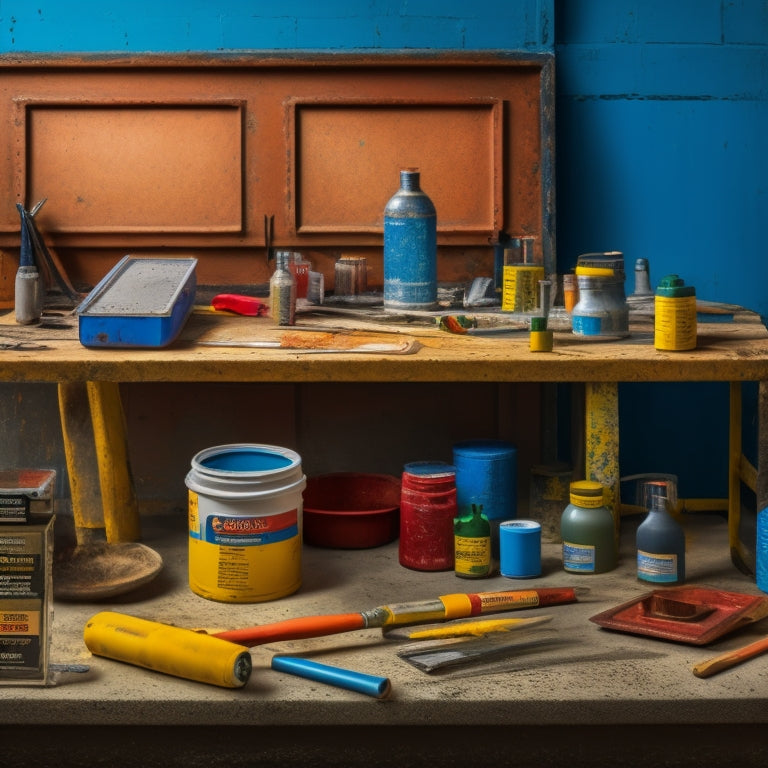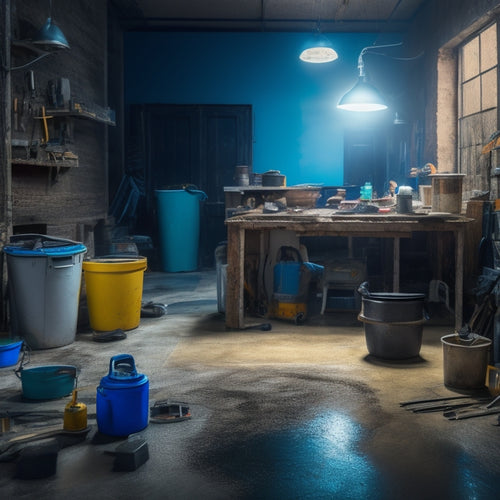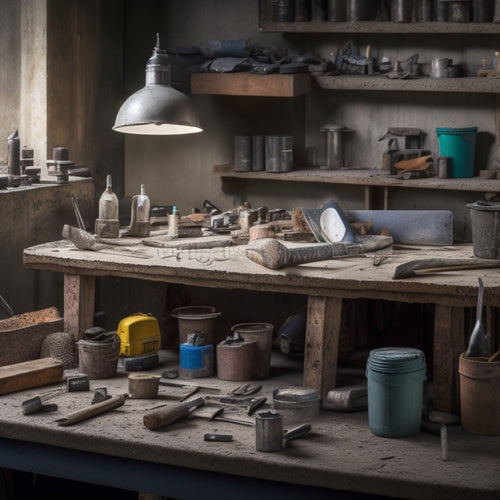
Top Tools for Painting Concrete Blocks Like a Pro
Share
You'll need a range of specialized tools to achieve a professional-looking finish when painting concrete blocks. Start with high-quality paint options like epoxy, acrylic, or latex-based paints, and prep the surface with wire brushes, power washers, and degreasers. Invest in stiff-bristled brushes or roller extension poles, and complement them with microfiber rollers for smooth surfaces or wool/mohair rollers for textured ones. Don't forget rugged paint trays with built-in grids, cleaning tools like scrubbers and degreasers, safety gear like gloves and respirator masks, and measuring tools like tape measures and laser levels. With these essentials, you'll be well on your way to transforming your concrete blocks into a stunning work of art - and there's more to explore to guarantee a flawless finish.
Key Takeaways
• Invest in high-quality paint options like epoxy, acrylic, or latex-based paint for a durable finish on concrete blocks.
• Prepare the surface by cleaning with wire brushes or power washers, and filling cracks and holes with concrete patching compound.
• Choose the right brushes, such as stiff-bristled or roller extension poles, with synthetic bristles and sturdy handles for smooth application.
• Select the appropriate roller and extension pole, considering nap length, material, and stability features, for efficient coverage.
• Don't forget essential safety gear, including gloves, masks, safety glasses, and protective clothing, to prevent health risks during painting.
Essential Painting Supplies
Before diving into the painting process, gather the following essential supplies to guarantee a successful and professional-looking finish.
You'll need a high-quality paint specifically designed for concrete blocks, such as epoxy, acrylic, or latex-based paints. These paint types offer excellent adhesion, durability, and resistance to fading. Additionally, consider the sheen level, ranging from flat to high-gloss, depending on your desired aesthetic.
Next, focus on surface preparation. A clean and even surface is vital for a smooth paint application.
You'll need a wire brush or power washer to remove dirt, grime, and old coatings. A degreaser may be necessary to eliminate oil or grease stains.
Once clean, fill any cracks or holes with a concrete patching compound and sand to a smooth finish.
Don't forget to tape off surrounding areas, such as windows, doors, and trim, to prevent paint from seeping onto unwanted surfaces.
With these essential supplies in hand, you'll be well-prepared to tackle your concrete block painting project with confidence.
Best Paintbrushes for Blocks
Select a high-quality paintbrush specifically designed for concrete blocks, such as a stiff-bristled brush or a roller extension pole, to guarantee a smooth, even application and ideal coverage.
You'll want to opt for brushes with synthetic bristles, which are more durable and resistant to wear and tear, especially when working with rough concrete surfaces. Angled brushes are also a great choice, as they allow you to reach into corners and crevices with ease.
When choosing the right brush, consider the size of your blocks and the area you need to cover. A larger brush will cover more surface area, but may be more difficult to maneuver in tight spaces.
Look for brushes with sturdy handles and comfortable grips, which will reduce fatigue and improve control. Additionally, consider the type of paint you're using, as some brushes are specifically designed for use with latex, oil-based, or epoxy paints.
Rollers and Extensions Needed
You'll need to complement your paintbrushes with the right rollers and extension poles to efficiently cover large areas and reach high or hard-to-access sections of your concrete blocks.
When selecting rollers, consider the nap length and material. Microfiber rollers with a shorter nap (around 1/4 inch) are ideal for smooth concrete surfaces, while longer nap rollers (around 1/2 inch) are better suited for rougher surfaces.
For extension poles, you'll want to choose lengths that allow you to reach high areas comfortably. Typical extension lengths range from 4 to 12 feet, but you may need longer or shorter poles depending on your specific project.
When selecting a roller type, consider the surface you're working with. Foam rollers are great for smooth surfaces, while wool or mohair rollers are better for textured surfaces.
Additionally, look for rollers with a sturdy core and a secure attachment to the extension pole to guarantee stability and control.
With the right rollers and extension poles, you'll be able to efficiently cover large areas and reach those hard-to-access spots, guaranteeing a professional-looking finish for your concrete blocks.
Perfect Paint Trays Matter
With the right rollers and extension poles in hand, it's crucial that you pair them with a high-quality paint tray designed specifically for concrete blocks, as it will greatly impact the overall efficiency and effectiveness of your painting process.
When it comes to paint tray types, you'll want to opt for a tray with a rugged, textured surface that can withstand the rough texture of concrete blocks. This type of tray will help prevent paint from pooling and guarantee a smooth, even application.
When choosing a paint tray, consider the paint application techniques you'll be using. For example, if you'll be using a heavy, textured finish, you'll want a tray with deeper wells to hold more paint. On the other hand, if you're going for a smooth, uniform finish, a shallower tray will suffice.
Additionally, look for trays with built-in grids or screens to help remove excess paint and prevent drips. By selecting the right paint tray for your specific needs, you'll be able to achieve professional-looking results with ease.
Cleaning Tools for Success
As you prepare to tackle your concrete block painting project, having the right cleaning tools on hand will help prevent paint buildup and secure a smooth, even finish.
You'll need a combination of scrubbers, brushes, and cleaning solutions to remove dirt, grime, and old coatings from the surface of the blocks. A wire brush or scrubber is ideal for rougher surfaces, while a soft-bristled brush is better suited for smoother blocks. When it comes to cleaning solutions, opt for a degreaser or a masonry cleaner specifically designed for concrete. These products will help break down dirt and grime, making it easier to remove them from the surface.
Proper surface preparation is critical to a successful paint job. Use your cleaning tools to remove any loose debris, dirt, or old coatings from the blocks. Then, use a cleaning solution to scrub the surface, making sure to rinse thoroughly with clean water.
This will secure a strong bond between the paint and the concrete, resulting in a long-lasting, professional-looking finish. By investing in the right cleaning tools and taking the time to properly prepare the surface, you'll set yourself up for success and achieve a finish that's worthy of a pro.
Safety Gear for Protection
Protect your skin, eyes, and lungs from harsh chemicals and paint particles by wearing essential safety gear, including gloves, safety glasses, and a respirator mask. You don't want to compromise your health while painting concrete blocks.
Here are the must-haves for a safe and protected painting experience:
-
Durable gloves: Prevent skin irritation and abrasion with heavy-duty gloves that can withstand rough concrete surfaces and harsh chemicals.
-
Protective masks: Respirator masks with filters trap paint particles and fumes, ensuring you breathe safely while working in enclosed spaces.
-
Safety glasses: Shatter-resistant lenses protect your eyes from paint splatters, debris, and accidental spray.
- Long-sleeved clothing and pants: Cover your skin with breathable, protective clothing to prevent skin exposure to harsh chemicals and paint.
Measuring and Marking Tools
Measuring and marking tools help you accurately calculate the surface area of your concrete blocks and transfer your design onto the surface with precision. As a pro, you know that getting the measurements right is essential to achieving a flawless finish.
You'll need a reliable tape measure, a calculator, and a pencil to get started. For more complex designs, consider investing in a laser level, which will help you achieve perfect leveling techniques. This tool projects a level line across the surface, guaranteeing your design is straight and even.
When it comes to marking methods, you'll want to use a high-contrast marker or chalk to create crisp, clear lines. For more intricate designs, try using a stencil or a template to achieve precise shapes and patterns.
Don't forget to use a straightedge or a ruler to keep your lines straight and your curves smooth. With the right measuring and marking tools, you'll be able to tackle even the most complex designs with confidence and precision.
Frequently Asked Questions
Can I Use Exterior House Paint on Concrete Blocks?
You're wondering if you can use exterior house paint on concrete blocks. While it's technically possible, it's not the best choice.
Concrete blocks require specialized paint that can withstand harsh weather conditions and the alkalinity of the concrete.
Look for paint types specifically designed for masonry, such as elastomeric or epoxy-based paints, which provide a durable, long-lasting finish.
Using the right paint will guarantee a professional-looking result that can withstand the elements.
Do I Need to Prime the Blocks Before Painting?
Break out your Renaissance-era artisan skills, because we're about to get medieval on those concrete blocks!
Now, about priming - you're probably wondering if it's necessary. The answer is a resounding 'yes!'
Priming offers benefits like increased adhesion, reduced paint consumption, and enhanced color vibrancy. Choose from a range of primers, such as epoxy-based, acrylic, or silane-modified polyether.
Don't skip this essential step - prime those blocks to guarantee a pro-level finish that'll make the masters proud!
How Long Does It Take for Concrete Block Paint to Dry?
When you apply concrete block paint, you're probably wondering how long it'll take to dry.
The drying time depends on environmental factors like temperature, humidity, and air circulation. Typically, the paint will be touch-dry in 1-2 hours.
However, it's crucial to wait for the recommended 24 hours for full paint curing. During this time, avoid exposing the surface to water or heavy traffic to guarantee a strong, durable finish that'll withstand the test of time.
Can I Paint Concrete Blocks in Direct Sunlight?
You're wondering if you can paint concrete blocks in direct sunlight, and rightly so.
Let's debunk the myth that sunlight is always beneficial. In reality, direct sunlight can hinder paint adhesion and cause it to dry too quickly, leading to uneven finishes.
When you paint in direct sunlight, the surface temperature can exceed 140°F, causing the paint to dry before it can properly bond with the concrete.
Is It Necessary to Seal the Painted Concrete Blocks?
When you're done painting, you're probably wondering if sealing the concrete blocks is a must. The answer is yes, it's highly recommended.
Sealing the blocks enhances paint durability, protecting it from fading, chalking, and cracking. You'll also reap sealing benefits like improved stain resistance and reduced maintenance.
Conclusion
With precision and patience, you've prepped and painted your concrete blocks to perfection.
Now, step back and savor the sight of your sparkling, solid-hued slabs.
Your skillful strokes and meticulous methods have morphed mundane blocks into magnificent masterpieces.
You've mastered the art of painting concrete blocks like a pro, and your precision project is a demonstration of your prowess.
Related Posts
-

7 Must-Have Tools for Concrete Repair Organization
To effectively organize your concrete repair projects, you'll need a thorough toolkit that includes a well-planned st...
-

Essential Tools for Epoxy Concrete Floor Repair
You'll need a thorough arsenal of specialized tools to guarantee a successful epoxy concrete floor repair. Floor prep...
-

Top Tools for Concrete Repair Success
When it comes to concrete repair success, you'll need a well-stocked toolkit with essential hand tools like trowels, ...


